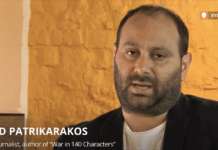By Forrest Hindley —
After these things I looked, and behold, a great multitude which no one could count, from every nation and all tribes and peoples and tongues, standing before the throne and before the Lamb, clothed in white robes and palm branches were in their hands; (10) and they cry out with a loud voice, saying, “Salvation to our God who sits on the throne, and to the Lamb.” (11) And all the angels were standing around the throne and around the elders and the four living creatures; and they fell on their faces before the throne and worshiped God, (12) saying, “Amen, blessing and glory and wisdom and thanksgiving and honor and power and might, be to our God forever and ever. Amen.”
(13) Then one of the elders answered, saying to me, “These who are clothed in the white robes, who are they, and where have they come from?” (14) I said to him, “My lord, you know.” And he said to me, “These are the ones who come out of the great tribulation, and they have washed their robes and made them white in the blood of the Lamb. (15) “For this reason, they are before the throne of God; and they serve Him day and night in His temple; and He who sits on the throne will spread His tabernacle over them. (16) “They will hunger no longer, nor thirst anymore, nor will the sun beat down on them, nor any heat; (17) for the Lamb in the center of the throne will be their shepherd and will guide them to springs of the water of life; and God will wipe every tear from their eyes.”
(Revelation 7:9-17 New American Standard)
My life as a Christian began as a senior at the University of Southern California. Raised a Christian Scientist (neither Christian nor scientific), I read the Gospels and Acts before coming to the conviction that I was a sinner, that Jesus was not just a great teacher but rather the Son of God, and that He died on the cross not just to show His great love but to pay the penalty for my sins.
I remain a conservative evangelical holding a literal view of Scripture. I also view God’s relationship & promises to Israel as unique and binding, distinct from Christ’s workings and promises to His bride the Church and also unique to His calling of Saints during the Tribulation period.
But my retirement has enabled me to take a fresh look at some of the things I personally proclaimed for decades. One of these widely-accepted dogmas has to do with the nature of the multitude in Revelation 7. My conclusion now differs from that commonly preached.
The “Multitude” passage follows a Tribulation interlude in Revelation 7:3-8 involving the sealing of 144,000 Jews, where an angel cries out, “Do not harm the earth or the sea or the trees until we have sealed the bond-servants of our God on their foreheads.” Verse 4: “And I heard the number of those who were sealed, one hundred and forty-four thousand sealed from every tribe of the sons of Israel”, followed by a listing of 12,000 from each tribe.
Then verse 9 & 10 tell us, “After these things I looked, and behold, a great multitude…”
At this point, many preachers will interject, see what “144,000 Jewish Evangelists” can do! Now, unlike most Reformed and Covenant theologians, I am fully convinced that these “from every tribe” reflect more than a remnant but a full Jewish nation which has finally embraced Messiah Jesus, as described in Romans 11 (“there has also come to be at the present time a remnant according to God’s gracious choice…a partial hardening has happened to Israel until the fulness of the Gentiles has come in; and so all Israel will be saved” Romans 11:5,25,26). These 144,000 are sanctified and protected during the Tribulation, as described in Revelation 9:4 and 14:1-5. But, where does it describe these 144,000 as being evangelists to the world? I find nothing. Of course, many during this period will believe and as Tribulation Saints be martyred. But why should Rev 7’s “multitude” be attributed to the 144,000 just because the account follows “after these things”!
I take a literal view of the Book of Revelation, except where something is clearly described as symbolic (ie. In Revelation 12:1-9, the woman=Israel, the dragon=Satan and the child=Jesus). I also view most of Revelation’s account of the Tribulation as sequential. But just because Revelation 7:1-8 precedes Revelation 7:9-17 does not necessarily mean that the event caused the second half’s events! Logic would label that a fallacy of post hoc ergo propter hoc (“after this, therefore because of this”). Just because B follows A doesn’t necessarily mean that A caused B!
But, many will say, “Revelation 7:14 tells us that the great multitudes are martyred saints who are continually coming out of the Great Tribulation! These multitudes must be the tremendous fruit of the Jewish 144,000 evangelists!” Are they sure? We’ll discuss the use of verse 14’s “erchomenoi” as a present continuous Greek verb a little later. But for now, let’s back up to Revelation’s first martyr reference in chapter 6, verses 9-11. This “Fifth Seal” lies at the beginning of the Tribulation account…
Revelation 6:9-11
When the Lamb broke the fifth seal, I saw underneath the altar the souls of those who had been slain because of the word of God, and because of the testimony which they had maintained. (10) and they cried out with a loud voice, saying, “How long, O Lord, holy and true, will you refrain from judging and avenging our blood on those who dwell on the earth?” (11) And there was given to each of them a white robe; and they were told that they should rest for a little while longer, until the number of their fellow servants and their brethren who were to be killed even as they had been, would be completed also.
Let’s also look at the report of the martyred saints toward the end of the Tribulation…
Revelation 14:12-13
Here is the perseverance of the saints who keep the commandments of God and their faith in Jesus. (13) And I heard a voice from heaven, saying, “Write, Blessed are the dead who die in the Lord from now on!” “Yes,” says the Spirit, “so that they may rest from their labors, for their deeds follow with them.”
So, I was told, and for many years preached, that the “martyrs” of Revelation 6 are the same as the “multitude” of Revelation 7, who now have recovered and are praising the Lord, serving in the Temple night and day! So, let’s take a close look and compare…”
Identity: In Rev 6 & 14, they are clearly identified as slain; Rev 7 makes no mention of martyrdom, identifying them as “from every nation and all tribes and peoples and tongues”. (cf. Rev 5:9-10)
Location: In Rev 6, the martyrs are “underneath the altar”; in Rev 7, they are “standing before the
throne.”
Speech: In Rev 6, they cry out for vengeance; in Rev 7, they cry out in praise.
Attire: Of course, they both are dressed in white robes, as are all saints in Heaven.
Activity: In Rev 6, they are told to rest, and they continue to do so in Rev 14; In Rev 7, “they serve Him day & night in the Temple”.
Duration: In Rev 6, the martyrs are told “to rest…until their servants and their brethren who were to be killed even as they had been should be completed also”. The numbers are still not complete in Rev 14:12-13! So how could these same martyrs be standing before the throne in Rev 7, waving palm branches, and serving in the temple night and day?
Numbers: In Rev 6, the martyred saints are being counted until “complete”; In Rev 7:9, there is “a great multitude which no one can count”.
Recognition: In Rev 6:9, John knew who the martyrs were; in Rev 7:14, John didn’t recognize them.
Description: In Rev 6 & 14, they suffered martyrdom (beheading, in 20:4) and cried out for vengeance;
While Rev 7 describes suffering in v.16-17, there is no mention of martyrdom.
So, do the saints in Revelation 7:9-17 sound like the same Tribulation Martyrs as in Revelation 6:9-11 & 14:12-13, then resurrected (raptured) in Revelation 20:4?
But what about that Greek verb “erchomenoi” we find in Revelation 7:14? Essentially, all conclusions regarding the identity of “the multitude” as risen Tribulation Martyrs revolve around this one Greek word! It’s ending defines it normally as a “present continuous verb” in the Greek. For this reason, ESV translates it as “the ones coming out”, as does Berean Literal, Holman, and Young’s, implying that they keep coming out. But the NIV translates it “who have come out”, as does Berean Standard, Good News, NET, and New Revised Standard. But the King James translates it “they which came out”, as does Aramaic, Webster’s, and World English. The New King James translates “the ones who come out”, as does New American Standard, and Amplified. And Douay-Rheims translates it “they who are come out” (as if they were “come-outers”). So, there appears to be great confusion in translation of the one Greek verb “erchomenoi” in v. 14!
For context, we should look first at the question being asked in verse 13: “These who are clothed in the white robes, who are they, and where have they come from?” This Greek verb translated “come”, “elthon”, is an “aorist” tense, defined as a single point in time (usually in the past), not a present continuous. So, the question being asked involves saints whom John saw who seem to have suddenly appeared!
Now let’s consider the expertise of Greek scholar Henry Alford, author of ALFORD’S GREEK TESTAMENT- An exegetical and Critical Commentary. On page 628, he writes concerning “erchomenoi” in Revelation 7:14…
“And he said to me, ‘These are they that come’ (not, as E.V., “that came,” nor again must the present be put prominently forward, “that are coming”, as if the number in the vision were not yet complete; still less is it to be taken as a quasi-future, “that shall come”; but as in the expression “o erchomenos” (the ones who come), the present is merely one of designation. Their description, generically, is that “they are they that come,” out of the great tribulation”.
To summarize, Henry Alford states that the verb “erchomenoi” is to be translated in Revelation 7:14 where “the present is merely one of designation.” We might refer to it as “a present state-of-being verb”. Combining with verse 13, where John saw the Saints that had suddenly appeared, these are “they who are come out” as Douay-Rheims translated. They are the “come-outers” of the Great Tribulation, who are continually present in heaven, “a great multitude which no one could count, from every nation and all tribes and peoples and tongues, standing before the throne and before the Lamb, clothed in white robes, and palm branches were in their hands. (10) and they cry out with a loud voice, saying, “Salvation to our God who sits on the throne, and to the Lamb.” (Revelation 7:9-10)
So why is this important? Because it is one more verification that the Church during this age will be raptured and present with the Lord in Heaven at the beginning of The Tribulation!
Mark 13:35 “Therefore, be on the alert—for you do not know when the master of the house is coming…”
Revelation 6:15-17 (at The Tribulation’s beginning)
And the kings of the earth & the great men & the commanders & the rich & the strong & every slave & free man, hid themselves in the caves and among the rocks of the mountains; (16) and they said to the mountains and to the rocks, “Fall on us and hide us from the presence of Him who sits on the throne, and from the wrath of the Lamb; (17) for the great day of their wrath has come; and who is able to stand?”
I Thessalonians 5:9-11
For God has not destined us for wrath, but for obtaining salvation through our Lord Jesus Christ, (10) who died for us, so that whether we are awake or asleep, we will live together with Him. (11) Therefore encourage one another and build up one another, just as you also are doing. (cf. I Thessalonians 1:10)
I Thessalonians 4:16-18
For the Lord Himself will descend from heaven with a shout, with the voice of the archangel and with the trumpet of God, and the dead in Christ will rise first. (17 )Then we who are alive and remain will be caught up together with them in the clouds to meet the Lord in the air, and so we shall always be with the Lord. (18) Therefore, comfort one another with these words.
Forrest Hindley graduated suma cum laude from USC’s Marshall School of Business in 1972. After committing his life to Christ, he served 4 years as a Naval Supply Corps Officer attached to the SeaBees, and then entered Talbot School of Theology, graduating with his Master of Divinity in 1980. Forrest served in various pastoral roles before planting a church in Rancho Cucamonga, where 2/3rds were new believers. He was ordained in the Evangelical Free Church. In 1993, Forrest joined his father’s business as a financial planner so he could touch more lives outside the church. Retiring in 2015, Forrest is now free to explore the Scriptures, especially those involving end times. Today, Forrest & his wife Debby lead an outreach ministry within their neighborhood, while attending Rocky Mountain Calvary Chapel.



